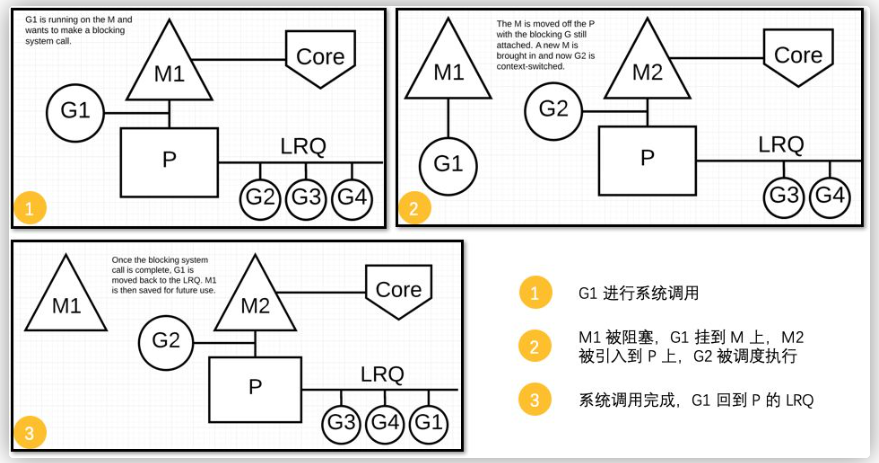原创文章,欢迎转载,转载请注明出处,谢谢。
0. 前言
第八讲介绍了当 goroutine 运行时间过长会被抢占的情况。这一讲继续看 goroutine 执行系统调用时间过长的抢占。
1. 系统调用时间过长的抢占
看下面的示例:
func longSyscall() {
timeout := syscall.NsecToTimeval(int64(5 * time.Second))
fds := make([]syscall.FdSet, 1)
if _, err := syscall.Select(0, &fds[0], nil, nil, &timeout); err != nil {
fmt.Println("Error:", err)
}
fmt.Println("Select returned after timeout")
}
func main() {
threads := runtime.GOMAXPROCS(0)
for i := 0; i < threads; i++ {
go longSyscall()
}
time.Sleep(8 * time.Second)
}longSyscall goroutine 执行一个 5s 的系统调用,在系统调用过程中,sysmon 会监控 longSyscall,发现执行系统调用过长,会对其抢占。
回到 sysmon 线程看它是怎么抢占系统调用时间过长的 goroutine 的。
func sysmon() {
...
idle := 0 // how many cycles in succession we had not wokeup somebody
delay := uint32(0)
...
for {
if idle == 0 { // start with 20us sleep...
delay = 20
} else if idle > 50 { // start doubling the sleep after 1ms...
delay *= 2
}
if delay > 10*1000 { // up to 10ms
delay = 10 * 1000
}
usleep(delay)
...
// retake P's blocked in syscalls
// and preempt long running G's
if retake(now) != 0 {
idle = 0
} else {
idle++
}
...
}
}类似于运行时间过长的 goroutine,调用 retake 进行抢占:
func retake(now int64) uint32 {
n := 0
lock(&allpLock)
for i := 0; i < len(allp); i++ {
pp := allp[i]
if pp == nil {
continue
}
pd := &pp.sysmontick
s := pp.status
sysretake := false
if s == _Prunning || s == _Psyscall { // goroutine 处于 _Prunning 或 _Psyscall 时会抢占
// Preempt G if it's running for too long.
t := int64(pp.schedtick)
if int64(pd.schedtick) != t {
pd.schedtick = uint32(t)
pd.schedwhen = now
} else if pd.schedwhen+forcePreemptNS <= now {
// 对于 _Prunning 或者 _Psyscall 运行时间过长的情况,都会进入 preemptone
// preemptone 我们在运行时间过长的抢占中介绍过,它主要设置了 goroutine 的标志位
// 对于处于系统调用的 goroutine,这么设置并不会抢占。因为线程一直处于系统调用状态
preemptone(pp)
// In case of syscall, preemptone() doesn't
// work, because there is no M wired to P.
sysretake = true
}
}
if s == _Psyscall {
// Retake P from syscall if it's there for more than 1 sysmon tick (at least 20us).
// P 处于系统调用之中,需要检查是否需要抢占
// syscalltick 用于记录系统调用的次数,在完成系统调用之后加 1
t := int64(pp.syscalltick)
if !sysretake && int64(pd.syscalltick) != t {
// pd.syscalltick != pp.syscalltick,说明已经不是上次观察到的系统调用了,
// 而是另外一次系统调用,需要重新记录 tick 和 when 值
pd.syscalltick = uint32(t)
pd.syscallwhen = now
continue
}
// On the one hand we don't want to retake Ps if there is no other work to do,
// but on the other hand we want to retake them eventually
// because they can prevent the sysmon thread from deep sleep.
// 如果满足下面三个条件的一个则执行抢占:
// 1. 线程绑定的本地队列中有可运行的 goroutine
// 2. 没有无所事事的 P(表示大家都挺忙的,那就不要执行系统调用那么长时间占资源了)
// 3. 执行系统调用时间超过 10ms 的
if runqempty(pp) && sched.nmspinning.Load()+sched.npidle.Load() > 0 && pd.syscallwhen+10*1000*1000 > now {
continue
}
// 下面是执行抢占的逻辑
unlock(&allpLock)
// Need to decrement number of idle locked M's
// (pretending that one more is running) before the CAS.
// Otherwise the M from which we retake can exit the syscall,
// increment nmidle and report deadlock.
incidlelocked(-1)
if atomic.Cas(&pp.status, s, _Pidle) { // 将 P 的状态更新为 _Pidle
n++ // 抢占次数 + 1
pp.syscalltick++ // 系统调用抢占次数 + 1
handoffp(pp) // handoffp 抢占
}
incidlelocked(1)
lock(&allpLock)
}
}
unlock(&allpLock)
return uint32(n)
}进入 handoffp:
// Hands off P from syscall or locked M.
// Always runs without a P, so write barriers are not allowed.
//
//go:nowritebarrierrec
func handoffp(pp *p) {
// if it has local work, start it straight away
// 这里如果 P 的本地有工作(goroutine),或者全局有工作的话
// 将 P 和其它线程绑定,其它线程指的是不是执行系统调用的那个线程
// 执行系统调用的线程不需要 P 了,这时候把 P 释放出来,算是资源的合理利用,相比于线程,P 是有限的
if !runqempty(pp) || sched.runqsize != 0 {
startm(pp, false, false)
return
}
...
// no local work, check that there are no spinning/idle M's,
// otherwise our help is not required
if sched.nmspinning.Load()+sched.npidle.Load() == 0 && sched.nmspinning.CompareAndSwap(0, 1) { // TODO: fast atomic
sched.needspinning.Store(0)
startm(pp, true, false)
return
}
...
// 判断全局队列有没有工作要处理
if sched.runqsize != 0 {
unlock(&sched.lock)
startm(pp, false, false)
return
}
...
// 如果都没有工作,那就把 P 放到全局空闲队列中
pidleput(pp, 0)
unlock(&sched.lock)
}可以看到抢占系统调用过长的 goroutine,这里抢占的意思是释放系统调用线程所绑定的 P,抢占的意思不是不让线程做系统调用,而是把 P 释放出来。(由于前面设置了这个 goroutine 的 stackguard0,类似于 运行时间过长 goroutine 的抢占 的流程还是会走一遍的)。
我们看一个示意图可以更直观清晰的了解这个过程:

handoff 结束之后,增加抢占次数 n,retake 返回:
func sysmon() {
...
idle := 0 // how many cycles in succession we had not wokeup somebody
delay := uint32(0)
for {
if idle == 0 { // start with 20us sleep...
delay = 20 // 如果 idle == 0,表示 sysmon 需要打起精神来,要隔 20us 监控一次
} else if idle > 50 { // start doubling the sleep after 1ms...
delay *= 2 // 如果 idle 大于 50,表示循环了 50 次都没有抢占,sysmon 将加倍休眠,比较空,sysmon 也不浪费资源,先睡一会
}
if delay > 10*1000 { // up to 10ms
delay = 10 * 1000 // 当然,不能无限制睡下去。最大休眠时间设置成 10ms
}
if retake(now) != 0 {
idle = 0 // 有抢占,则 idle = 0,表示 sysmon 要忙起来
} else {
idle++ // 没有抢占,idle + 1
}
...
}
...
}2. 小结
本讲介绍了系统调用时间过长引起的抢占。下一讲将继续介绍异步抢占。